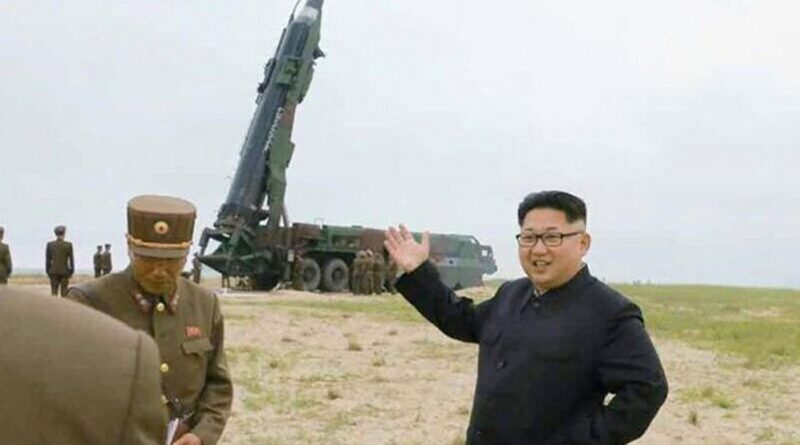North Korea’s Current Status: Armed And Infected – Analysis
It appears that North Korea is hunkering down for what comes next on issues related to the country’s security, but also what occurs next in the US. A coronavirus disease (COVID-19) lockdown in one North Korean city has already occurred, with perhaps more to follow depending on the virus’ spread and other factors. No doubt North Korea is at an interesting moment, where the country’s cultural-political “Juche” ideology is dealing with some immediate domestic needs and challenges.
The country last month addressed its COVID-19 problem. Supreme Leader Kim Jong Un convened an emergency politburo meeting and took a decision to shift to the “maximum emergency system” against coronavirus “after a runaway returned home from South Korea with coronavirus symptoms.” Some are arguing that this is a moment of weakness by Pyongyang, as it is asking for help. This aspect is far from the truth. Pyongyang’s objective in the politburo meeting was to enact its government protocol based on its system of governance. The Stalinist-era politburo stage was one of strength, not weakness. The hammer and sickle were prominent.
Kim’s visit to the Fatherland Liberation War Martyrs Cemetery two weeks ago to mark the 67th anniversary of the end of the 1950-53 war was also highly significant. Kim laid a single rose and bowed before the war monument. He said: “The undying feats of the defenders of the fatherland in the 1950s, who provided the valuable mental heritage of the revolution amid the flames of the hard-fought war, would shine long in history.”
The icing on the cake, if you will, was Kim honoring the war with gifts based on the sacred North Korean mountain, Mount Paektu. Kim, with the help of his sister, gave “Paektusan” commemorative pistols to North Korea’s senior army officers. The Paektusan name comes from Mount Paektu. It is important to remember that Mount Paektu, which is the highest peak on the Korean Peninsula, is considered the sacred birthplace of the Korean people. The North claims that national founder Kim Il Sung led anti-Japanese guerrilla forces at the mountain to fight for independence from the 1910-45 colonial rule, and that late leader Kim Jong Il, the father of the current leader, was born there. It is the mountain that the North Korean leadership rides up on horses.
The ceremony was also an interesting point in Kim’s rule. His sister, Kim Yo Jong, the most likely heir apparent, played an important role in the ceremony. Her very presence, combined with her earlier comments to South Korea and the US, shows her increasing power. Kim will not live forever and, in order to continue with Juche, the Paektu family “will to power” will continue.
North Korea is also pressing on with its nuclear weapons program and several countries know that it is miniaturizing nuclear devices to fit into the warheads of its ballistic missiles, while also working with light water reactors. Pyongyang has not conducted a nuclear test since September 2017. Perhaps Kim or his sister may see utility in a test close to the American election or after a possible Joe Biden win, thereby challenging his administration immediately.
Simultaneously, domestic challenges make the regime perhaps more cautious, meaning it wants to puff out its chest. Here is where North Korea is putting its Juche face first.
Climate change is battering North Korea. It continues to see historic levels of rainfall, which further threatens an economy already battered by the coronavirus outbreak. Torrential rains have flooded hundreds of homes and wiped out vast swaths of rice fields in the country’s agricultural heartland, which intensifies concerns of a poor harvest and subsequent food supply shortage.
The extent of the damage is not precisely known. Kim this month visited a flood-hit village in North Hwanghae province, where 600 hectares of rice fields and more than 900 homes were inundated or destroyed. Hwanghae is the North’s most important rice-producing province. Officials warned that rivers in both Hwanghae and the nearby province of Kangwon could overflow. The rains are already more intense than those of 2007, when North Korea saw some of its worst floods on record. The rest of this year is likely to bring more damage.
There are unanswered questions about how much of a challenge COVID-19 will be in North Korea. The government delivered aid packages of food and medical equipment to the residents of Kaesong, near the border with the South, after imposing a lockdown to contain the spread. Footage shows hundreds of people wearing masks and sitting apart from one another at a party auditorium. They were thanking authorities for the aid, with some breaking down in tears.
Finally, what happens in the US in the coming months matters to Pyongyang, especially the November presidential election. North Korea already feels emboldened by poking both America and South Korean “in the eyes” by closing itself off from negotiations. The North Korean state is preparing, fortifying and contending with current perceived threats. A Biden win may eventually set up a confrontation between Washington and a possible new North Korean leader in Kim Yo Jong. The damage done from South Korea’s perspective may be undone. The same is true with Japan. But containing China is a potentially long-term US strategic goal and that fact will punish Beijing, especially over the new Hong Kong security law and what happens next with Taiwan.
North Korea will witness a changing landscape if Donald Trump is voted out of office. COVID-19 may be infecting the country, but neighboring aid will be available. Down the road, US-North Korean relations will rise to a new level of confrontation with this new alignment of actors. A nuclear test by Pyongyang would be an interesting salvo.

